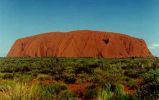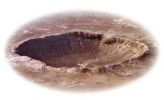
WHAT IS THE BARRINGER METEORITE CRATER?
The Barringer Meteorite Crater (also known as "Meteor Crater") is a gigantic hole in the middle of the arid sandstone of the Arizona desert. A rim of smashed and jumbled boulders, some of them the size of small houses, rises 150 feet above the level of the surrounding plain. The crater itself is nearly a mile wide, and 570 feet deep.
When Europeans first discovered the crater, the plain around it was covered with chunks of meteoritic iron - over 30 tons of it, scattered over an area 8 to 10 miles in diameter.
David Roddy, USGS.
HOW DO WE KNOW WHAT MADE IT?
The process of scientific discovery involves the development of hypotheses, tentative explanations which may or may not account for the observable facts. A good scientific hypothesis will generate a number of logical consequences or predictions, which are capable of being tested directly. Ultimately, the hypothesis will be accepted as valid only if:
repeated tests of these predictions, by different investigators, tend to confirm it;
it is consistent with other well-confirmed hypotheses;
it is more useful than other hypotheses in accounting for a broad range of observed facts; and
it is more economical or "elegant" than other hypotheses, in the sense of requiring fewer additional assumptions.
Although meteorite falls had been reported for thousands of years, until this century no one had ever identified a crater created by such a fall. Even a meteorite as large as the 66-ton Hoba, the largest ever discovered, may be slowed so much by the Earth's atmosphere that it lands without making a significant hole.
In 1891 Grove Karl Gilbert, then chief geologist for the U.S. Geological Survey, decided to test two conflicting hypotheses about the crater. The first was that the crater was created by the impact of a giant meteorite; the second, that it was the result of an explosion of superheated steam, caused by volcanic activity far below the surface.
If an iron meteorite had created the crater, Gilbert assumed that it would have had to be nearly as big as the crater itself. So what predictions could he test?
First, the meteorite should be taking up a lot of space in the hollow of the crater. The volume of the hollow would therefore be less than the volume of the ejected material in the crater rim. Second, the presence of a large mass of buried iron should affect the behavior of magnets and compass needles. Neither prediction was confirmed. Gilbert concluded that a steam explosion was the only surviving hypothesis, in spite of the fact that no volcanic rocks had ever been found in the area. The meteorites around the crater were simply a coincidence.
The Barringer Meteor Crater
Rate this file
(No vote yet)
(No vote yet)
File information
Filename:
The Barringer Meteor Crater.jpg
Album name:
Keywords:
The Barringer Meteor Crater
File Size:
14 KB
Dimensions:
350 x 213 pixels
URL:
Favorites:






![Filename : ulurutop[1].jpg
Filesize : 39KB
Dimensions : 589x365
Date added : Dec 21, 2005 ulurutop[1].jpg](http://hamaraphotos.com/albums300/userpics/10628/thumb_ulurutop%5B1%5D.jpg)




